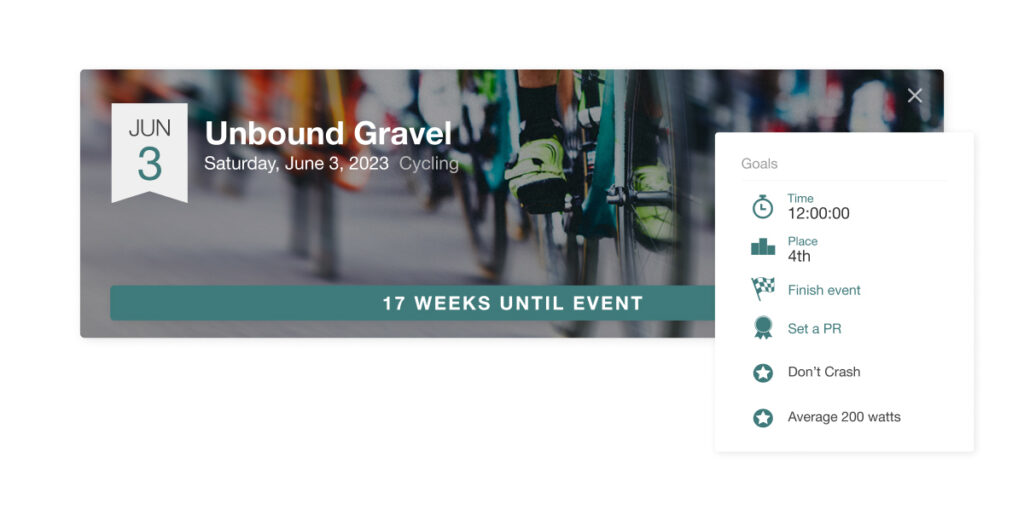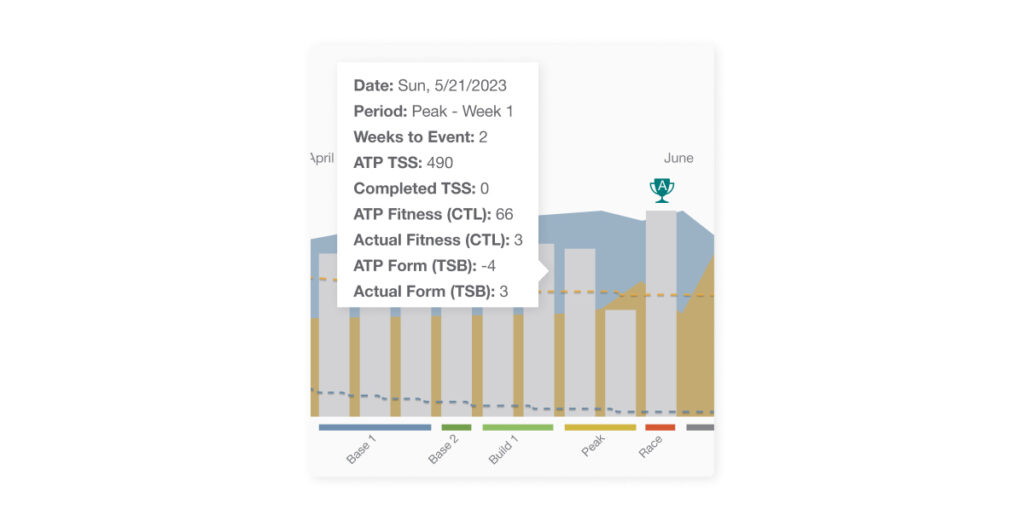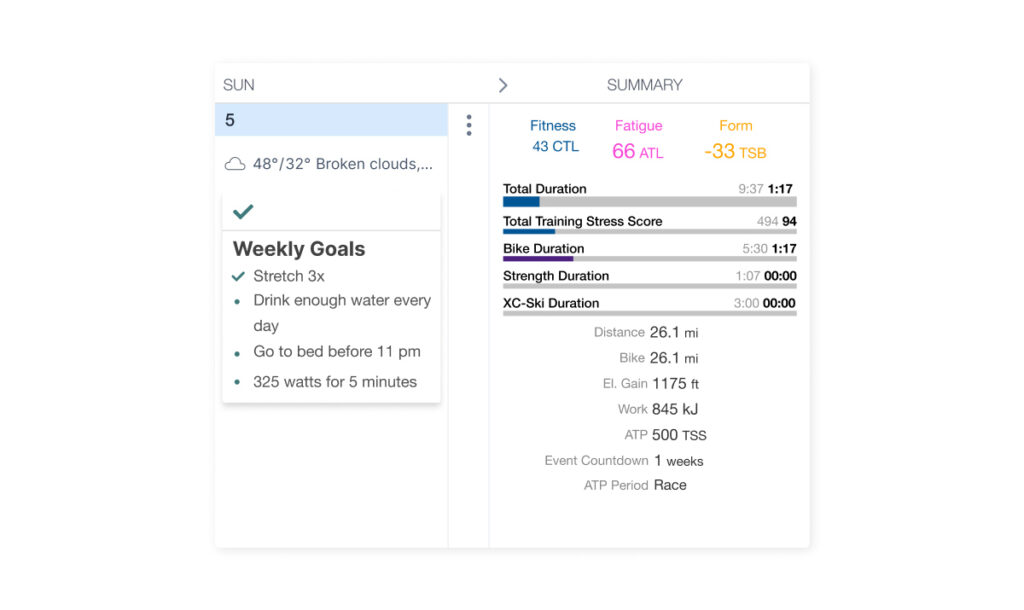Most endurance athletes have long-term goals that span a season or more. Even if you don’t compete or participate in official events like centuries or charity runs, putting some time into refining your goals will help you stay on track and motivated throughout the year. Here are four basic steps to quantify your fitness goals in a way that makes it easier to plan your training season so that each week and training cycle moves you towards those goals. We’ll also review some TrainingPeaks features that can help as well.
Step 1: Identify Your Fitness Goals
Before planning your season, you need a clear understanding of what you want to achieve. Whether it’s a specific race or competition, or simply a personal best, make sure your goals are SMART (Specific, Measurable, Attainable, Relevant, and Timely). We won’t go in-depth on SMART goals here, as other articles cover the concept more thoroughly. But in short, this is how you take a goal like “get better at bike racing” to “finish on the podium in my local race series by the end of September.”
While goals like this can be easier to define for competitive athletes by using finishing places or time, even non-competitive athletes can apply all the same concepts. A non-competitive runner, for instance, could set a goal like “finish a specified route or distance by a specific date or in a specific amount of time”.
Once you have a goal, you can add it to your calendar in TrainingPeaks as an event. If your goal is part of an official event, you can add additional details like goal finishing time. Even if your goal isn’t part of an event, you should still add it to the calendar as an Event calendar item, as that will allow you to take advantage of other features in TrainingPeaks – more on that later.

Step 2: Define Your Process and Outcome Goals
Once you have your long-term goals in mind, you can break them down into a series of process and outcome goals.
Process goals are things you can do that you have direct control over to reach your end goal. They include everything you do in training and recovery on a daily or weekly basis to give yourself the best chance of achieving outcome goals (i.e., milestones or checkpoints to ensure that you are on the right track to achieve your end goal).
In endurance sports, outcome goals are often performance metrics relevant to your end goal (e.g., peak power at specific durations, 5k pace, mid-season “B” race results, etc.). The relationship between performance metrics like power or pace and success in different disciplines and how specific training affects those metrics is complex and multi-faceted and can quickly become overwhelming, so we’ll leave some of those details to your coach or training plan. Instead, we’ll focus on one fundamental aspect of training that is important to manage for all endurance athletes — volume.
Step 3: Determine Your Target Numbers
Once your goal is on your TrainingPeaks calendar, you can use the Annual Training Plan (ATP) feature to create weekly volume goals for you automatically. Set your goal as an “A” priority event and use the ATP setup wizard to build your annual training plan. The ATP will create a weekly periodization plan to help you manage your training cycles with recommended weekly training volume targets.
To unlock the full power of the ATP, consider building it based on Training Stress Score (TSS) instead of hours. TSS is a volume metric that combines workout duration and intensity to give you a more accurate idea of how much you have been training. Even if you’ve never used TSS before, it’s easy to start. For long-term planning purposes, you can estimate TSS from duration by multiplying hours by 50 — so if you have 10 hours a week on average available to train, you can configure your ATP for 500 TSS per week.
If you have more flexibility and want to train based on a peak fitness level you want to achieve instead of an average weekly volume, you can set your ATP based on Target CTL (Chronic Training Load). CTL is a weighted average of your daily TSS over the previous six weeks and is an indicator of general fitness. It is one of three related Performance Management metrics you can use to ensure you are training enough, not overtraining, and peaking at the right time. You can use these tables to see the range of Target CTL values across different disciplines and populations.
Once you have a draft ATP, don’t forget to modify it for known events that may increase or decrease your ability to train for a given week, like a planned vacation or training camp.

Note: if you are following a training plan, the author may use a different coaching methodology than the ATP uses, so don’t try to mix the two. If you are working with a coach, talk to them about the specifics of your annual plan if you are unsure.
Step 4: Train and Track Your Progress
Once you have finished your ATP, you can configure your TrainingPeaks calendar to display the training volume targets in the weekly summary. You will see visual progress toward your weekly volume goal as you complete workouts each day. As you finish each week, you will know if you are on track with your ATP and can make adjustments as you go. As was said earlier, the best way to reach those weekly volume goals (the specificity of workouts, distribution, and timing of intensity, etc.) is complicated, so we’ll leave those details to your coach or the training plan or methods you use as a self-coached athlete.

These steps should give you a good idea of how to take a big, vague, long-term goal and break it down into actionable steps, and then how to track your progress against the end goal. Training volume is just one example. Now you can apply the same approach to other types of process goals and milestones like:
- Using Peak Performances and Stackup to track your progress with various power or pace goals.
- Using Dashboard charts to optimize your health and recovery with metrics like sleep, HRV, and resting heart rate.
- Using the “Goals” calendar item to manage simple “checkbox” goals that don’t get recorded as workouts or metrics (stretching or foam rolling sessions, bedtimes, or anything else you want to establish as a habit to give yourself the best chance for success).









